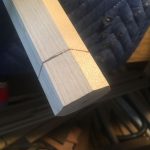We may receive a commission when you use our affiliate links. However, this does not impact our recommendations.
A 360 degree VR shot of the CNC setup in my shop. Just click and drag around the image to have a look around.
It’s never too early to think about space
In the back of your head, you might be thinking that one day it’s possible that you might add a CNC to your shop, then you’ve got a lot to think about.
There’s a number of factors that go into a woodworker taking the plunge into digital woodworking. The size, space, and cost of a CNC, software choices, integration and workflow changes, learning CAD, CAM and more. Each of these is a topic deserving of several blog posts or articles, but I thought that I’d start off with an overall consideration to get you thinking about it. As a first step, let look at the impact a CNC could have in your shop. Other than cost and learning the question I’m most often asked is, “how much space do I need?”
The question I ask in return is, “what do you want to do with it?” In my case, I look at a CNC as a versatile tool for hybrid woodworking. Like everyone, I’d like to get the most out of my tools and use them to get real work done. Therefore, when it comes to a CNC I want to be able to cut patterns and parts for furniture, do joinery and 3D carving. These are jobs that usually require CNCs bigger than the smallest table top machines. That doesn’t mean that they have to be a large 4×8 CNC, but it does mean the machine will take up some of your precious workshop space.
How much space? A CNC with extra workspace around it takes up a noticeable amount of room in a workshop. Figure a 2×3 CNC takes up about a 4×6 space. A 4×4 might need 7×7. Basically, you should allow a few extra feet beyond the overall footprint in every direction. That makes a CNC much more like a large fixed tool. Closer to the footprint of a table saw than a router table. Let’s look at a couple of scenarios.
How does a CNC fit in an established workshop?
Unless you have a large shop, placing a CNC in an established workshop could be complicated. Particularly, if you already have a number of large fixed tools. In my case, I designed and planned my shop for a CNC years before I finally got one. Of course, the reality is that the assigned space quickly got filled up so, I had to rearrange my shop to make room for it. You might find yourself in that situation too.
Fortunately, after setting up a few shops, I picked up some lessons along the way. Starting with my first, very tiny shop, I put all my fixed tools on mobile bases.
Though my current shop is nearly 10 times the size of my first workspace, I’ve kept my tools mobile. Mobility allows me to store and use more tools in a limited space. I position them optimally as I need them and roll them out of the way when I don’t. They take up less room when idle. Only my table saw has a permanent home.
My fairly large twin spindle 3×6 CNC is also on wheels. It sits on heavy duty feet that rest on large pads that move the wheels out of the way when not needed. Though the CNC’s location in my shop is semi-permanent, I keep it mobile for another reason. I can move it out a bit when carving large pieces that are over 8’ in length.
What about fitting in a CNC in a small workshop?
As I’ve often mentioned, a CNC is unlike other power tools because of its unique versatility. It does a number of jobs well. And, although I use it regularly, I’m not planning on giving up most of my other power tools as long as I have room for them as dedicated tools are often faster and nice to have around for certain tasks. But for woodworkers with small shops, cost and the space requirements of any large tool are always important considerations.
There are various ways to accommodate a CNC in smaller shops. One is to put it on a mobile base so it can be rolled out of the way when not needed. But if your space is really limited, you might want to think of a CNC and the overall picture of a modern woodworking shop in a different way.
Depending on the work you want to do, it’s possible that the versatile CNC could also serve as a substitute for other single purpose power tools in the shop. For example, if you’re a dedicated hand tool woodworker with little shop space and a preference for jointer planes over powered-jointers, your shop could look like this:
- 2×4 CNC
- band saw
- router table
- table top drill press
- table top planer
- jobsite table saw
There are certainly other ways to approach the issue of shop space. Some woodworkers might work together and consider sharing a CNC at one location. Or, others may choose a different style CNC with a small footprint and expands its capability with a moveable table.
If you’re new to woodworking
If you’re new to woodworking, open to digital woodworking and haven’t yet fully equipped your shop, your approach to layout and function may be different than other woodworkers. You might take a more contemporary approach and centralize around a CNC instead of a table saw. Add a few additional fixed power tools, a joint making tool (like the Festool Domino or Leigh FMT for example), a good collection of hand tools and the skills to use them and as always, a great workbench.
In any case, even if you’re at the earliest stages of considering a digital tool like a CNC router for your shop, it’s never too early to start thinking about where it might live. Planning helps. I know from personal experience. I had the power, dust collection and the basic space worked out years early, I just forgot to allow a couple of feet around it in all directions.
Here are some supplies and tools we find essential in our everyday work around the shop. We may receive a commission from sales referred by our links; however, we have carefully selected these products for their usefulness and quality.








